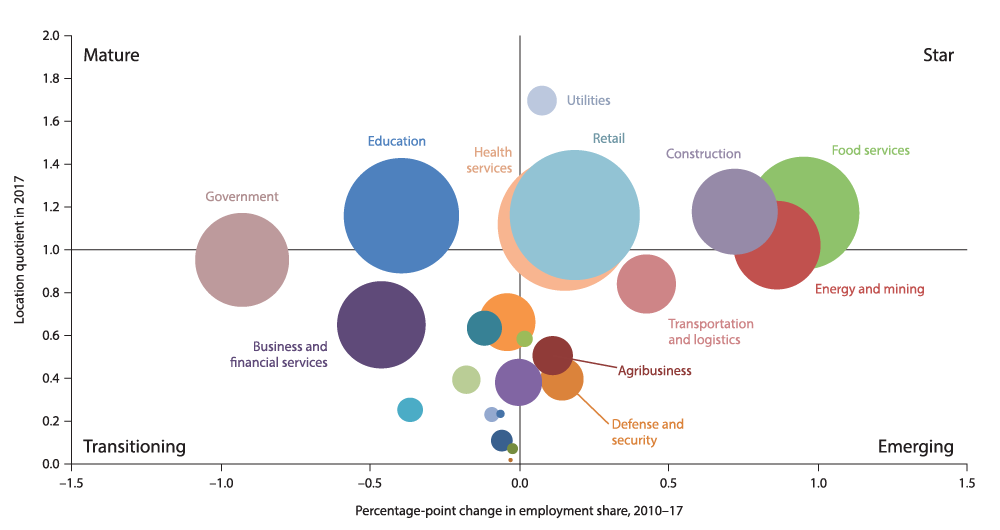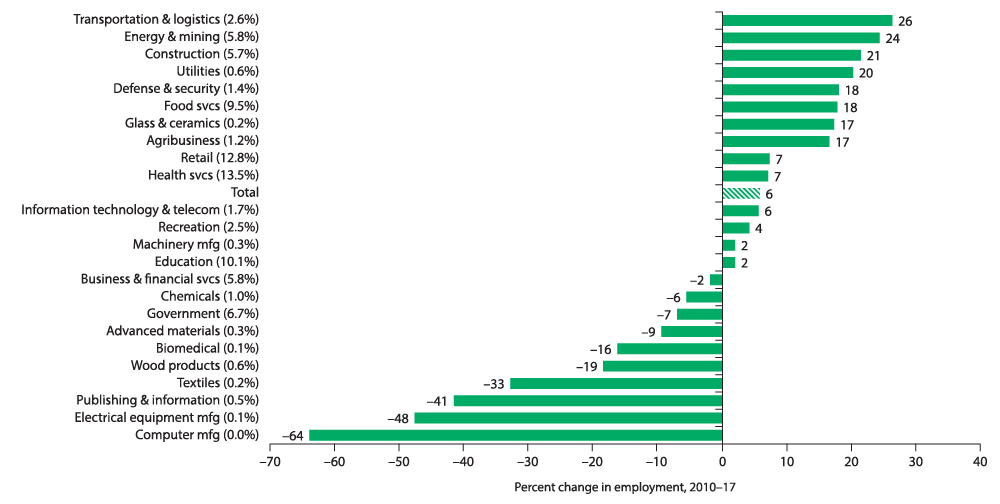At the Heart of Texas: Cities’ industry clusters drive growth
Amarillo: Services take root in panhandle’s ranching, transportation center
- Print version
- Additional tables: Amarillo location quotients, employment shares, average annual earnings, demographics
At a glance

Population (2017): |
264,925 |
Population growth (2010–17): |
4.8 percent (Texas: 12.1 percent) |
Median household income (2017): |
$53,922 (Texas: $59,206) |
National MSA rank: |
No. 184* |
| *The Amarillo metropolitan statistical area (MSA) encompasses Armstrong, Carson, Oldham, Potter and Randall counties. | |
- Amarillo initially flourished as a cattle-market hub, connecting ranches in the Panhandle to major urban markets by railroad. Large industrial plants, built after World War I to produce helium and weapons for the military, transformed the area, as did the discovery of oil and gas.
- Services have become the cornerstone of the economy while many manufacturing plants still thrive, contributing to comparatively low poverty and unemployment rates.
- The median household income trails the Texas average slightly but is higher than other metros of comparable size. The population is less diverse than that of the state. Domestic outmigration and tight labor markets may become a drag on future growth.
History: from ranching and trade hub to industrial complex
Amarillo has its origins in 1887 with the arrival of rail freight service, helping create a cattle-market center in the Texas Panhandle, serving area ranches and those in the South Plains and eastern New Mexico. Additional rail service after the turn of the century strengthened Amarillo’s standing in cattle shipping, and the city’s standing as a transportation hub rose during the 1930s with the convergence of four U.S. highways, including the famous Route 66.[1]
The community was originally named Oneida and later renamed Amarillo after the nearby lake and creek, which likely derived their name from the yellow soil along their banks or the yellow wildflowers plentiful during the spring and summer.
The area gained an industrial base with the discovery of natural gas in 1918 and oil three years later. Oil refineries and shipping facilities followed. Most significantly, the Cliffside gas field discovery in 1928 included helium-rich deposits, leading to the federal government’s establishment of the U.S. Bureau of Mines’ Amarillo Helium Plant. In 1942, the Pantex Ordinance Plant was opened for the production of bombs and ammunition. It subsequently became the nation’s premier nuclear weapons facility, today housing most of the national plutonium repository and encompassing 18,000 acres and 650 buildings.[2]
Industry clusters: retail, food services drive local economy
Location quotients (LQs), which compare the relative concentration of various industry clusters locally and nationally, are a convenient way of assessing key drivers in a regional economy. An LQ exceeding 1 indicates that a specific industry cluster carries more relative weight locally than nationally. Industry cluster growth is measured by the percentage-point change in the cluster’s share of local employment between 2010 and 2017 (Chart 10.1).[3]

NOTE: Bubble size represents cluster share of metropolitan statistical area employment.
SOURCES: Texas Workforce Commission; Bureau of Labor Statistics.
Clusters in the top half of Chart 10.1 are generally vital to the area’s economy and can be expanding rapidly relative to other clusters (“star”) or losing ground to other clusters (“mature”). Those in the bottom half are less dominant locally than nationally and have an LQ less than 1.
Most Amarillo workers are in service occupations, with 46 percent in the retail, health services, education and food services industry clusters. All of these clusters have LQs exceeding 1, indicating their outsized local contribution. Retail and food services are in the “star” category, with growing shares of the metro's employment. The largest employers include the Amarillo Independent School District, BSA Health System (formed from the 1996 combination of High Plains Baptist Hospital and St. Anthony’s Hospital), the Northwest Texas Healthcare System, the city of Amarillo and several higher-education institutions, including Texas A&M University in Canyon.[4]
Although the utilities cluster employs less than 1 percent of the workforce, its high LQ and above-average growth indicate its significance. Amarillo-based Southwestern Public Service, a large regional electric utility company with more than 800 employees (as of March 2018), is a subsidiary of Xcel Energy Inc. of Minneapolis. The energy and mining cluster, employing 5.8 percent of area workers, was among the fastest-growing sectors between 2010 and 2017, with total employment increasing 24 percent during the period (Chart 10.2). One factor in the growth of these two clusters is the Panhandle region’s importance as a producer of wind energy.[5] The metro increased its wind energy production capacity nearly 500 percent between 2010 and 2016, driving its share of the state’s electricity-generating capacity from 3 percent to 10 percent.

NOTES: Percent change in employment is shown in whole numbers. Each cluster's share of total jobs is shown in parentheses (rounded to one decimal place).
SOURCES: Texas Workforce Commission; authors' calculations.
While Amarillo has much lower shares of employment in manufacturing-related industries than the nation, production plants are among the largest private-sector employers. The defense and security cluster also grew rapidly from 2010 to 2017. The area is home to CNS Pantex, the nation’s primary facility for the final assembly, dismantlement and maintenance of nuclear weapons, which is managed and operated privately but overseen by the Department of Energy/National Nuclear Security Administration. It employed 3,200 people as of March 2018, 2.7 percent of metro workers. Additionally, Bell Helicopter’s production plant employs 1,000 workers. A Tyson Foods beef plant tied to Amarillo’s large cattle industry employs 2,280 people.
Average annual real (inflation-adjusted) earnings in Amarillo grew only 2.5 percent in 2010–17 (Table 10.1); this is below the state’s 5.7 percent wage growth rate. The metro’s wages are below the U.S. average in most industry clusters, and overall wages are 18.9 percent lower in Amarillo than in the U.S. Lower average wages in Amarillo partly reflect the low cost of living; adjusting wages for lower housing costs in particular would significantly reduce the wage gap vis-à-vis state and national wages.
| Cluster | Amarillo | U.S. | |||||
| 2010 | 2012 | 2014 | 2016 | 2017 | 2017 | ||
| Utilities | 86,768 | 88,877 | 92,126 | 98,899 | 103,833 | 107,188 | |
| Construction | 46,959 | 48,845 | 48,714 | 52,114 | 50,999 | 60,742 | |
| Food services | 14,984 | 15,562 | 15,950 | 16,148 | 16,257 | 18,963 | |
| Retail | 27,823 | 27,522 | 27,559 | 28,514 | 28,077 | 31,216 | |
| Education | 40,771 | 38,535 | 39,712 | 40,634 | 40,478 | 49,322 | |
| Health services | 50,480 | 49,070 | 47,992 | 50,479 | 50,434 | 56,001 | |
| Energy and mining | 62,848 | 54,275 | 60,319 | 58,012 | 60,167 | 80,900 | |
| Clusters with location quotient > 1 | 36,871 | 36,207 | 38,632 | 39,668 | 39,806 | – | |
| Clusters with location quotient < 1 | 51,044 | 50,002 | 49,392 | 50,955 | 51,211 | – | |
| Average earnings (total) | 43,813 | 43,270 | 43,510 | 44,619 | 44,891 | 55,375 | |
| NOTES: Clusters are listed in order of location quotient (LQ); clusters shown are those with LQs greater than 1. Earnings are in 2017 dollars. SOURCES: Texas Workforce Commission; Bureau of Labor Statistics; authors’ calculations. |
|||||||
Demographics: Incomes stagnate even as labor market remains tight
Amarillo’s real median household income grew 1.6 percent from 2014 to 2017 compared with 7.8 percent statewide. At $53,922, Amarillo’s median income was slightly below the state median of $59,206 in 2017—a relatively high income for a small city. Poverty rates are slightly lower than in the state; 15 percent of the local population and 18 percent of children live in poverty, compared with an overall statewide poverty rate of 16 percent and 22 percent among children.
Amarillo averaged the lowest unemployment rate among Texas metros in 2015 and 2016.
More than 60 percent of the population is non-Hispanic white; 28.4 percent of the population is Hispanic. The population rose in 2017 as net international migration and natural increase (births minus deaths) offset losses via domestic outmigration. The overall population grew 4.8 percent from 2010 to 2017.
Amarillo’s postsecondary education attainment among those ages 25 and older lags the state, with 23.7 percent possessing a bachelor’s degree or higher, compared with 28.9 percent statewide.
Expansion of wind-energy production will likely continue to lead future growth. Defense and security manufacturing and cattle production will remain mainstays of Amarillo’s economy, with an expected increase in export demand for beef aiding growth in the near term.[6]
—Stephanie Gullo
Notes
- The history of Amarillo has been adapted from the Texas State Historical Association’s Handbook of Texas, tshaonline.org/handbook/online/articles/hda02.
- Detail about Pantex’s current operations has been obtained from pantex.energy.gov/about.
- The percentage shares of individual clusters do not add to 100 because some industries are counted in multiple clusters, and some industries are not counted at all based on cluster definitions. (See the appendix for more information.)
- Data about major employers in Amarillo have been obtained from the Amarillo Chamber of Commerce, www.amarillo-chamber.org/major-employers.html.
- See “Wind Power a Growing Force in Oil Country,” by Justin J. Lee and Kelvinder Virdi, Federal Reserve Bank of Dallas Southwest Economy, Second Quarter, 2017, www.dallasfed.org/research/swe/2017/swe1702e.aspx.
- See “CattleFax Outlook: Cattle Profitability Remains for 2018,” by Wes Ishmael, Beef Magazine, Feb. 2, 2018, accessed May 7, 2018, www.beefmagazine.com/marketing/cattlefax-outlook-cattle-profitability-remains-2018.